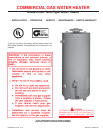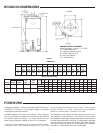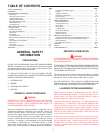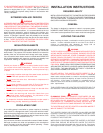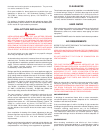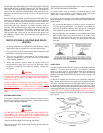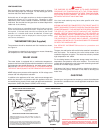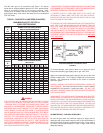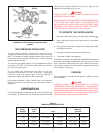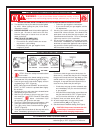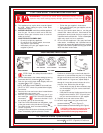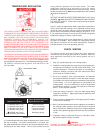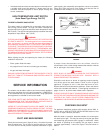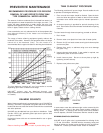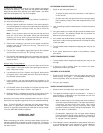
5
the heater and must be piped to an adequate drain. The pan must
not restrict combustion air flow.
Drain pans suitable for these heaters are available from your
distributor or Apcom Inc., 125 Southwest Parkway, Franklin,
TN 37065 or contact them by phone, 615-794-5574 or fax
615-791-0660.
For appliance installation locations with elevations above 2000
feet (610 meters), refer to HIGH ALTITUDE INSTALLATIONS section
of this manual for input reduction procedure.
HIGH ALTITUDE INSTALLATIONS
WARNING
INSTALLATIONS ABOVE 2000 FEET (610 METERS) REQUIRE
REPLACEMENT OF THE BURNER ORIFICE IN ACCORDANCE
WITH SECTION 8.1.2 OF THE NATIONAL FUEL GAS CODE (ANSI
Z223.1). FAILURE TO REPLACE THE ORIFICE WILL RESULT IN
IMPROPER AND INEFFICIENT OPERATION OF THE APPLIANCE
RESULTING IN THE PRODUCTION OF INCREASED LEVELS OF
CARBON MONOXIDE GAS IN EXCESS OF SAFE LIMITS WHICH
COULD RESULT IN SERIOUS PERSONAL INJURY OR DEATH.
You should contact your gas supplier for any specific changes
which may be required in your area.
As elevation above sea level is increased, there is less oxygen per
cubic foot of air. Therefore, the heater input rate should be reduced
at high altitudes for satisfactory operation with the reduced oxygen
supply. Failure to make this reduction would result in an overfiring
of the heater causing sooting, poor combustion and/or
unsatisfactory heater performance.
Ratings specified by manufacturers for most appliances apply for
elevations up to 2000 feet (610m). For elevations above 2000 feet
(610), ratings must be reduced at the rate of 4% for each 1000 feet
(305m) above sea level. For example, if a heater is rated at 78,000
Btuh (22.9 kWh) at sea level, to rate the heater at 4000 feet (1219m),
you subtract 4 (once for each thousand feet) x.04 (4% input
reduction) x 78,000 (original rating) from the original rating.
Therefore, to calculate the input rating at 4,000 feet (1219m): 4 x
.04 x 78,000 = 12,480 Btuh (3.7 kWh), 78,000 (22.9 kWh) - 12,480
(3.7 kWh) = 65,520 Btuh (19.2 kWh). At 6000 feet (1829m) the
correct input rating should be 59,280 Btuh (17.4 kWh).
The input reduction is primarily achieved by reducing the size
of the main burner orifices. To do this, the main burner
orifices require replacement with orifices sized for the particular
installation elevation. Correct orifice sizing and parts may be
obtained from Apcom Inc., 125 Southwest Parkway, Franklin, TN
37065 or contact them by phone, 615-794-5574 or fax
615-791-0660. When ordering, be sure to state the model number
and the altitude of the location where the water heater is being
installed.
Upon completion of derating of the heater, adjustment to the gas
pressure regulator may be required. See CHECKING THE INPUT
section in this manual for inlet and manifold pressure
requirements.
Also due to the input rating reduction required at high altitudes, the
output rating of the appliance is also reduced and should be
compensated for in the sizing of the equipment for application.
CLEARANCES
These heaters are approved for installation on combustible flooring
in a closet having a ceiling 12" (30.5cm) above top cover and with
clearances to combustible construction of 6" (15.2cm) from flue or
vent connector, 0" (0cm) at the sides and rear and 4" (10.1cm) to
front to prevent a possible fire hazard condition. A minimum of 4"
(10.1cm) shall be allowed for installation of serviceable parts.
HARD WATER
Where hard water conditions exist, water softening or the threshold
type of water treatment is recommended. This will protect the
dishwashers, coffee urns, water heaters, water piping and other
equipment.
See MAINTENANCE section for details of tank cleanout procedure.
AIR REQUIREMENTS
REFER TO THE LATEST EDITION OF THE "NATIONAL FUEL GAS
CODE" ANSI Z223.1/NFPA 54.
KEEP APPLIANCE AREA CLEAR AND FREE OF COMBUSTIBLE
MATERIALS, GASOLINE AND OTHER FLAMMABLES, VAPORS AND
LIQUIDS.
DO NOT OBSTRUCT THE FLOW OF COMBUSTION OR
VENTILATING AIR.
WARNING
FOR SAFE OPERATION PROVIDE ADEQUATE AIR FOR
COMBUSTION AND VENTILATION. AN INSUFFICIENT SUPPLY
OF AIR WILL CAUSE RECIRCULATION OF COMBUSTION
PRODUCTS RESULTING IN AIR CONTAMINATION THAT MAY BE
HAZARDOUS TO LIFE. SUCH A CONDITION OFTEN WILL
RESULT IN A YELLOW, LUMINOUS BURNER FLAME, CAUSING
CARBONING OR SOOTING OF THE COMBUSTION CHAMBER,
BURNERS AND FLUE TUBES AND CREATES A RISK OF
ASPHYXIATION.
Where an exhaust fan is supplied in the same room with a heater,
sufficient openings for air must be provided in the walls.
UNDERSIZED OPENINGS WILL CAUSE AIR TO BE DRAWN INTO
THE ROOM THROUGH THE CHIMNEY, CAUSING POOR
COMBUSTION. SOOTING MAY RESULT IN SERIOUS DAMAGE
TO THE HEATER AND RISK OF FIRE OR EXPLOSION.
UNCONFINED SPACE
In buildings of conventional frame, brick, or stone construction,
unconfined spaces may provide adequate air for combustion,
ventilation and draft hood dilution.
If the unconfined space is within a building of tight construction
(buildings using the following construction: weather stripping, heavy
insulation, caulking, vapor barrier, etc.), air for combustion,
ventilation and draft hood dilution must be obtained from outdoors.
The installation instructions for confined spaces in tightly
constructed buildings must be followed to ensure adequate air
supply.
CONFINED SPACE
When drawing combustion and dilution air from inside a
conventionally constructed building to a confined space, such a
space shall be provided with two permanent openings, ONE IN



